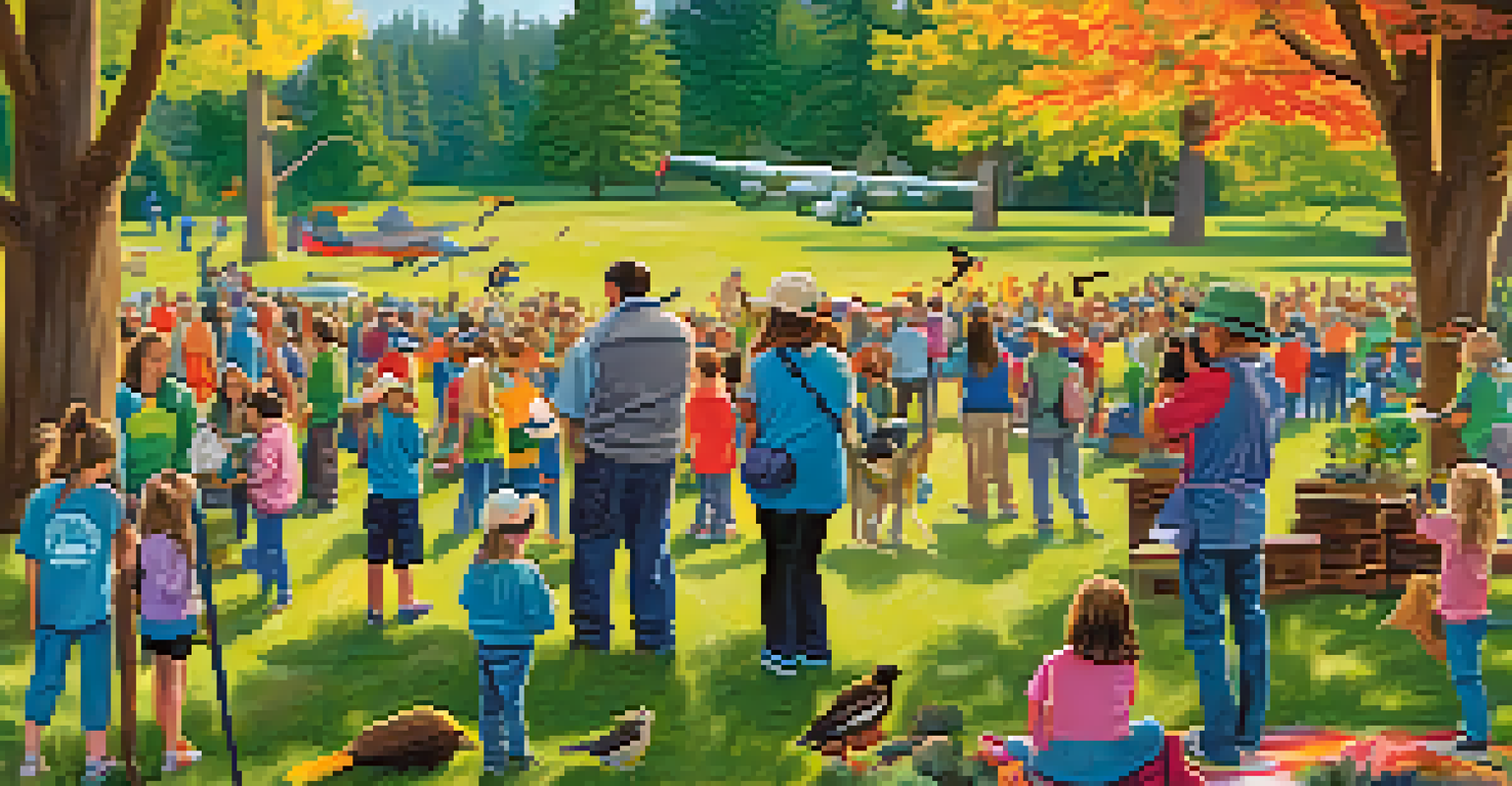Oregon's Birds: Conservation Efforts for Avian Species

Introduction to Oregon's Diverse Avian Population
Oregon is home to a rich tapestry of bird species, each adding to the state's vibrant ecosystem. From the majestic bald eagle soaring above the Cascade Mountains to the tiny hummingbirds flitting around gardens, these avian creatures are a vital part of both the environment and our lives. Understanding the diversity of these species helps highlight the importance of conservation efforts in the region.
The birds are our teachers. They show us the beauty of nature, the importance of conservation, and the need for action.
With over 500 species recorded, Oregon's birds inhabit a wide range of environments, including coastal areas, forests, and wetlands. This diversity not only contributes to the state's natural beauty but also indicates healthy ecosystems. However, many of these species face threats from habitat loss, climate change, and pollution, underscoring the need for effective conservation strategies.
By focusing on preserving and restoring habitats, Oregon aims to protect these avian populations. The state's commitment to conservation reflects a broader understanding that maintaining biodiversity is crucial for ecological balance, and the health of our planet depends on it.
Significant Threats Facing Oregon's Birds
Birds in Oregon face numerous threats that jeopardize their survival. Habitat loss due to urban development, agriculture, and forestry practices has drastically reduced the spaces where birds can live and breed. This fragmentation makes it challenging for species to find food and mates, ultimately impacting their populations.

Climate change is another pressing issue, altering migratory patterns and breeding seasons for many species. For instance, some birds may arrive at their nesting grounds too late to find sufficient food for their young. These changes can have cascading effects throughout the ecosystem, highlighting the interconnectedness of nature.
Oregon's Birds Face Serious Threats
Habitat loss, climate change, and pollution significantly threaten the diverse bird populations in Oregon.
Pollution also poses a significant threat, affecting the health of birds directly and indirectly. Chemicals in pesticides and plastics in waterways can harm birds, leading to decreased reproductive success and increased mortality rates. Addressing these threats requires a concerted effort from communities, government agencies, and conservationists.
Community Involvement in Bird Conservation
Community engagement is crucial for successful bird conservation efforts in Oregon. Local organizations and volunteers play a significant role in monitoring bird populations and habitats. By participating in activities like bird counts and habitat restoration projects, community members contribute valuable data and hands-on support to conservation initiatives.
In every walk with nature, one receives far more than he seeks.
Educational programs are also essential in raising awareness about the importance of protecting avian species. Workshops, school programs, and community events help people understand how their actions impact birds and their habitats. When communities are informed and involved, they become advocates for the birds they cherish.
Moreover, fostering a love for birds can inspire individuals to take personal actions, such as creating bird-friendly gardens or reducing plastic use. Each small effort can add up to significant changes, showcasing the power of collective action in conservation.
Key Conservation Organizations in Oregon
Several organizations in Oregon are at the forefront of bird conservation efforts. The Audubon Society of Portland has been a leader in protecting birds and their habitats through advocacy, education, and community involvement. Their initiatives often focus on both local and migratory bird species, promoting sustainable practices.
Another vital organization is the Oregon Department of Fish and Wildlife, which implements state-wide conservation programs aimed at preserving native bird populations. They conduct research, manage habitats, and collaborate with other agencies to ensure comprehensive protection for avian species throughout the state.
Community Plays Key Role in Conservation
Local engagement and education initiatives are essential for fostering awareness and support for bird conservation efforts.
Additionally, the Oregon Zoo participates in various conservation programs, including breeding and reintroduction efforts for endangered bird species. Their work emphasizes not only education but also active participation in restoring populations to their natural habitats, showcasing the zoo's commitment to wildlife conservation.
Restoration Projects Benefiting Bird Habitats
Restoration projects play a vital role in improving bird habitats across Oregon. These initiatives focus on rehabilitating wetlands, forests, and grasslands that have been degraded over time. By restoring these ecosystems, we can create safe havens for birds to nest, feed, and thrive.
One notable project is the Willamette Valley Wetlands Restoration, which aims to restore vital wetland areas that serve as critical habitats for migratory birds. These wetlands provide food and shelter during migration, helping to support diverse avian populations. The project's success highlights the importance of collaborative efforts between local governments, conservation groups, and volunteers.
Moreover, urban habitat restoration is gaining momentum, with cities implementing green spaces that attract birds. Parks and community gardens can provide essential resources for birds, demonstrating that even in urban settings, thoughtful design can support wildlife.
Research and Monitoring of Bird Populations
Research is fundamental to understanding the status and needs of bird populations in Oregon. Ongoing studies help track changes in population dynamics, migratory patterns, and the impacts of environmental factors. This data is crucial for informing conservation strategies and ensuring that efforts are focused where they are needed most.
Citizen science initiatives, such as the Christmas Bird Count, engage the public in monitoring bird populations. These activities not only provide valuable data but also foster a sense of connection and responsibility towards local wildlife. When people participate in research, they develop a deeper appreciation for the birds around them.
Restoration Projects Enhance Habitats
Restoration initiatives in wetlands and urban areas are vital for providing safe environments where birds can thrive.
Additionally, collaboration between universities, conservation organizations, and government agencies enhances research outcomes. By pooling resources and expertise, these partnerships can tackle complex questions about bird conservation, leading to more effective strategies and policies.
Future Directions for Bird Conservation in Oregon
Looking ahead, the future of bird conservation in Oregon will require innovative strategies and continued collaboration. As climate change poses new challenges, adaptive management practices will be essential. This means adjusting conservation efforts based on ongoing research and changing environmental conditions.
Furthermore, expanding community engagement will be vital for fostering a culture of conservation. By involving more people in bird conservation efforts, we can build a broader base of support and advocacy for protecting these species. Educational initiatives that inspire the next generation will help ensure that the importance of birds is recognized for years to come.

Finally, ongoing funding and resources will be critical to sustain these efforts. By securing financial support from government programs, grants, and community donations, conservation organizations can continue their vital work. Together, we can create a sustainable future for Oregon's birds, ensuring they continue to grace our skies.